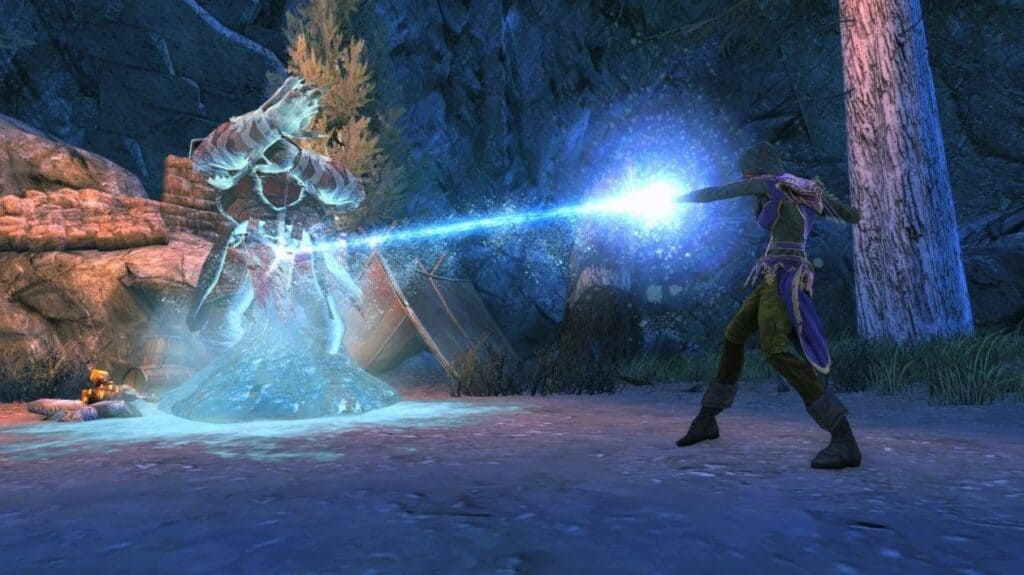There are plenty of fire and fire-like spells in D&D 5e, such as fireballs, sacred flame, and faerie fire. However, most people tend to overlook the rest of the damage types that the game has to offer. Frost and cold damage are one of those types, where ice spells often glance over.
Ray of Frost is one of those spells, but even though it isn’t as well-remembered as the fireball spell, it does solid damage and has a few interesting effects that every single caster might want to consider having in their arsenal. Here’s our to Ray of Frost 5e Guide to this spell.
What Is Ray Of Frost?
The spell has these stats according to the player’s handbook:
- evocation cantrip
- Casting Time: 1 action
- Range: 60 feet
- Components: V S
- Duration: Instantaneous
- Classes: Sorcerer, Wizard
A frigid beam of blue-white light streaks toward a creature within range. Make a ranged spell attack against the target. On a hit, it takes 1d8 cold damage, and its speed is reduced by 10 feet until the start of your next turn
The spell’s damage increases by 1d8 when you reach the 5th Level (2d8), 11th level (3d8), and 17th level (4d8)

Let’s break down the spell. First, it is an evocation cantrip that requires a vocal and somatic component. It can be used by sorcerers and wizards and has a range of 60 feet. It takes one action to cast and you will need to make a ranged spell attack.
If the spell attack hits, then the target takes 1d8 cold damage and also has their movement speed slowed by 10 feet until your next turn. As you reach higher levels the damage goes up. First things first, it is a cantrip level spell, which means that you can use it as much as you want as long as you have it prepared for that day. No need to burn any spell slots.
Secondly, and here’s the cool part, you don’t need to upcast the spell. Rather than having to burn a 2nd level spell slot to get an extra D8 of damage, you simply need to be level 5 and the damage goes up on its own. That’s awesome for casters because it gives you the extra damage for the spell while you still are casting the cantrip. That means you can save your spell slots for something else.
It also has a pretty impressive range of 60 feet and is a ranged spell attack. This means that it either hits or misses, so you won’t need to worry about enemies taking a saving throw to avoid the damage or the slowdown.
Now, here’s the interesting part. On a hit, the target’s movement speed is slowed down by ten feet until the start of your next turn. In order to see just how impactful that is, we need to talk a bit about movement in 5e.
A Basic Guide To Movement in 5e
Almost all the battle maps you play on, whether online or in-person, are divided up into squares. Most of these squares represent 5 feet of movement, and your character can move equal to their movement speed, with the average being 30 ft of movement or 6 squares per turn.
Some characters in light armor or those who are more graceful can have 40 feet of movement, while heavier characters or those wearing heavy armor are slower with 20 feet of movement. Of course, there’s also flying, swimming, and climbing speed which are their own sets of rules.
Most enemies fall into this range of movement too, and if you are faster than your foes you can close the distance between you or make a run for it. If you are slower than your foes you might want to try and outrun someone else. Controlling the battlefield through speed is something that the tactically minded player can take advantage of, especially with a cantrip like Ray of Frost.
Using Ray Of Frost On The Battlefield

Let’s say your party is taking on one of the standard D&D creatures: the humble wolf. A wolf has 40 feet of movement speed, which is more than what most parties will have speedwise. And of course, wolves come in packs.
It can be very hard to run from a wolf pack, and even if you choose to fight them, most wolves use hit and run tactics to run up, bite at you, and then use the rest of their movement to run away. This can make the battle even harder as you are forced to use your actions to chase the wolves and to get them into melee range. And of course, they run away afterward.
But Ray Of Frost can be used to not only deal damage to the wolf’s meager HP pool but can also slow their speed from 40 to 30. This reduces the wolf’s speed down to the speed of the average player, and you can then overcome them in a straight fight. They won’t be able to run as fast, and you’ll be able to get them in a position where they can be cut down.
Ray of Frost can also be used if you find yourself in a very melee-oriented situation. If you are a caster and find yourself in melee range, you can zap your foes with the Ray of Frost Spell and then skedaddle out of there, knowing that your enemy is much slower and won’t be able to reach you until the start of their next turn. That buys you and your allies some time to react.
Slowing the target by 10 feet or 2 squares probably doesn’t seem that exciting, but once you get on the battle map where every single square matters, you’ll grow to love those extra spaces!
Ray Of Frost Vs Frostbite
There are two large ice-themed cantrips in the game, and if you find yourself needing to choose between the Frostbite cantrip or a Ray of Frost spell, you need to compare the two. Here are the stats for Frostbite according to the player’s handbook:
- Evocation cantrip
- Casting Time: 1 action
- Range: 60 feet
- Spell Lists. Druid, Sorcerer, Warlock, Wizard, Artificer
- Components: V, S
- Duration: Instantaneous
You cause numbing frost to form on one creature that you can see within range. The target must make a Constitution saving throw. On a failed save, the target takes 1d6 cold damage, and it has a disadvantage on the next weapon attack roll it makes before the end of its next turn.
At Higher Levels. The spell’s damage increases by 1d6 when you reach the 5th level (2d6), 11th level (3d6), and 17th level (4d6).

Now, we won’t break the spell down as we did Ray of Frost, but basically, you cast the spell and the target makes a Constitution saving throw. On a failed save, 1d6 cold damage is taken and then the target has a disadvantage on their next attack due to the numbing cold. Much like Ray of Frost, the damage dice goes up as you level up.
Comparing The Two
First, the Ray of Frost does 1d8 cold damage and slows down the speed of the target, while the Frostbite spell causes 1d6 cold damage and the target gets a disadvantage. So if you are looking for something that will cause damage the Ray of Frost has Frostbite beat.
However, you also need to look at the effects both spells have on their targets. Admittedly slowing down speed can be pretty good in larger areas against faster enemies. Plus, you attack the enemy with a ranged spell attack, and they either get hit or dodge the spell. However, if you have a lot of dungeons crawls where a -10 reduction in speed doesn’t matter as much or are fighting enemies who were slower anyway, then it isn’t the best spell.
Frostbite does less damage and also requires the target to make a saving throw. Constitution is a pretty high stat for 90% of monsters, so unless you have a very high spell DC, the monsters you cast the spell on might shrug off the cold. However, the extra disadvantage can be very helpful whenever you need some breathing room against tougher enemies.
Plus, no matter what happens or whenever you are in combat, you will always need to inflict disadvantages on your enemies. It’s always pretty useful. You just need to roll pretty high to cut through the monster’s high CON. Still, if you can, the free disadvantage can turn the tide of the battle.
Ray Of Frost FAQs
Question: Is It A Utility Spell?
Answer: Most players, are content to use combat spells in combat, but there’s always one or two who want to use their spells more than just in combat. If your Ray of Frost player decides they want to act like Bobby Drake’s Iceman, then you can talk with them about how it isn’t a utility spell. While some people think that the ray of frost is powerful enough to freeze lakes over and add reinforcement to doors, it doesn’t work that way.
One of the strategies that some DMs use to illustrate what the spell can and can’t do is to think about liquid nitrogen. If you were to throw a vial of liquid nitrogen at a humanoid, they would get cold and suffer those ill effects. However, if you throw that same vial into a lake, you’d be lucky to get an ice cube out of it all.
So, you should talk to your players to let them know while the Ray of Frost might slow down an enemy and freeze them, it isn’t strong enough to do much more unless you cast the spell repeatedly. Even then, that’s a lot of power for not a lot of results.
Question: How Should We Roleplay Ray Of Frost?
Answer: Since the spell requires a verbal and somatic component, you could go full Elsa the Ice Queen and zap your enemies while singing. You could also make some cold puns and keep freezing your enemies with both the ray and your terrible choice of words.
You could even target the different areas of your enemy’s body. You could zap the legs of a wolf and slow them down while they run. You could fire the ray at a bugbear’s club arm and weigh it down to cause them to stumble. You could even ice over a dragon’s wings to give them some extra weight.
Of course, this is all roleplay and cosmetic detail, but you can have fun with it and give yourself a reason why you are slowing your foe down. Plus, it might let your party get more detailed with combat as well, which makes it much more fun at the end of the day.
Question: Should I Build A Cryo-Focused Character?
Answer: Elemental-themed characters are always interesting to play, as are themed characters who are built around certain doctrines or abilities. If you look at cantrips that deal with the ice and the cold, you could build a Cyro-caster if you want.
There are various spells from all levels that are focused on the cold, and some of these include Absorb Elements, Ice Knife, Cone Of Cold, Ice Storm, and also potions of cold resistance, and other magical items that reduce the cold.
It’s a lot of fun to build a themed character, and you can easily create a backstory that focuses on cold, the mountains, snow, and the howling wind. Cryo-focused spells focus on damage and also slowing targets down.
Of course, you might need to speak to your DM to flavor some existing spells to help them focus on ice and water magic. Make sure to talk things out and see what can be done, but most DM’s will gladly help their players make a reasonably powered themed character. Then they can weave the story together with your theme, and that adds more to the entire game.
- DnD Demons Guide: What Are Demons in 5e? - September 18, 2021
- Detect Thoughts 5e Guide: When, Why and How to Use It - September 9, 2021
- The Ultimate DnD Toll the Dead 5e Guide - September 9, 2021

